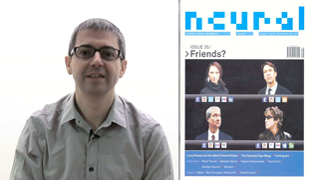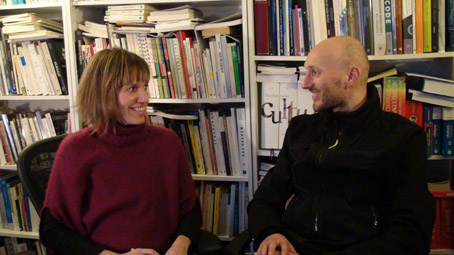In a keynote lecture on uncreative writing at the Berlin-based media arts festival transmediale in February 2013, Kenneth Goldsmith demonstrated his Internet-age update of literary writing, with avant-garde poetry generated through Google searches and JPEG images whose pixels were glitched through the insertion of the text of Shakespeare plays into their source code. For a general audience, this was an accessible eye-opener on otherwise abstract media theoretical debates of cultural change through new technology. For seasoned followers of new media art, it seemed like a rehash of late–1990s net.art experiments in the field of literary writing. In any case, these “aesthetics of failure” are thoroughly yet, using the terminology of American composer Kim Cascone, could be simultaneously called “post-digital”: It is an approach to digital media that no longer seeks technical innovation or improvement, but considers digitization something that already happened and can be played
with.Post-Digital Print, Onomatopee, 2012″ name= »retour au texte » href= « #note2″>[2], and unlike electronic music, electronic poetry has so far remained in a small academic niche [4].This has changed only recently with younger generation contemporary art, particularly from the USA, and the popularity of (commercial) Internet platforms such as tumblr for art that takes the form of found third-party material, or, in contemporary art jargon, art as curatorship [5]. Currently, the blog HyperAllergic is the best resource on this tendency in contemporary art. In March 2013, it will co-host an event called “The World’s First Tumblr Art Symposium” in Brooklyn[6].
For communication media and artistic production, digitization and the Internet mean a historical rupture just as, for example, neoliberal globalization meant a caesura for world economics or the rise of monotheism two thousand years ago changed world religions.
Yet in all these examples, the rupture is neither absolute nor synchronous, but an asynchronous process, occurring in different speeds and over different periods and being culturally diverse in each affected area. The term “post-digital” is partly ludicrous because it wrongly implies only one single moment of a historical break. It is not ludicrous as a descriptor of the reaction of arts to the cultural impact of digitization, rather than the heroic narrative of artists as technological innovators who prototype mainstream development that is typical for the mainstream field of “media art”. That electronic musicians reacted to digital technology by playing with its glitches rather than buying into its marketing promise of improved, cleaner fidelity – the same promise that is still effective when, selling, for example, 3D and 4K TV sets – is just one side of the story.[7] Nobody but experts can see the difference between cleanly shot and project analog 35mm film and digital 4K video; the characteristics of any medium only reveal themselves in its misbehavior at the low end.
After giving his keynote in Berlin, Kenneth Goldsmith was asked by Annette Frick, a subcultural photographer who had been documenting the queer and artistic underground of the city for decades, to have his picture taken. He was intrigued by her proposal not because of Frick’s reputation – since he wasn’t familiar with her work -, but because of her camera, a 1960s analog Mamiya 6×6 medium format Twin Lens Reflex. Superficially, it was ironic that the radical proponent of a digital copy-and-paste poetics would be charmed by old media technology and its attributes: slowness of process instead of quick gratification, craftsmanship instead of poetry made by all [8], highest quality reproduction instead of bandwidth-saving compression. But this seeming irony or contradiction really wasn’t one on a larger scale of post-digitality.
In a time where publishers and “creative” writers insist on realist prose printed on paper, pasting a Shakespeare poem into a JPEG file counts as a defiant concept of writing.
But in the same time, where all press photographers shoot with digital cameras, shooting with a medium format camera on film – in the venue’s women’s toilet, it should be added, because it was the only space that provided enough light -, is just as much an anti-mainstream media attitude.
Post-digitality, in a 2013 definition, can therefore overlap with what is otherwise called “retro media” or, to quote Simon Reynolds, “Retromania” [9]. What Reynolds, from his pop music historian perspective, misses to see in his much-discussed 2011 book on “Pop Culture’s Addiction to Its Own Past” is that the contemporary renaissance of vinyl and audio cassettes [10] have different cultural significance than, for example, a Motown or a punk revival. To quote his introduction, retro “is always about the relatively immediate past, about stuff that happened in living memory” [11]. Vinyl and cassettes indeed meet those criteria; the lack of a larger scale renaissance of, for example, reel-to-reel tape recorders backs up Reynolds’ point. On the other hand, there is a contemporary logic to the return of vinyl after mp3 and, more generally, the distribution of music as files had rendered CDs clumsy hybrids of mp3s and classical records – lacking the flexibility of a file while also lacking the crafty visuality and tangibility of the LP and the DIY cassette. Vinyl and cassettes have thus become post-digital media. They exist today only because they compensate for deficiencies of digital files – deficiencies that are both aesthetic and social, since tangible media are means of face-to-face interpersonal exchange. Exactly the same is true for the booming media of artistic printmaking: zines are made because they are not blogs, artists’ DIY books are printed because they are not web sites or PDFs.
One could write an alternative history of the Western modern arts as a struggle with industrialization.
In this history, there would be almost no connection between classical fine art painting to the modern arts, but it would start with medieval craftsmanship, continue with the Arts & Crafts movement in the 19th century, Bauhaus in the 20th century and end with the contemporary “creative industries” including most of contemporary artistic practice, including artist-made books, zines, cassettes, vinyl, but also electronic circuit bending, Fablab making and software hacking. In Richard Sennett’s 2008 book “The Craftsman”, this arts tradition has found its bible [12]. For Sennett, craftsmanship transgresses manual labor and encompasses all forms of productive making, from carpeting to artists’ work and the coding of the Linux kernel [13]. Sennett points out that there is no binary divide between craftsmanship and industrial production.
Similarly, artists’ DIY movements since Arts & Crafts – and including Fluxus and punk, for example – were struggling between either resistance to or embracing of industrial production. Fluxus multiples and punk zines were both simultaneously: handmade and mass-reproduced objects. Their DIY tradition therefore inspired both radical anti-copyright digitality – from early artist-run net.art platforms like The Thing to Goldsmith’s uncreative writing – and post-digital DIY making, from contemporary DIY film labs that gave birth to neo-structuralist 16mm film makers like Ben Rivers and Luke Fowler, to artists’ zines [14].
The term “post-digital” is just as ambiguous – and prone to reactionary misappropriation [15] – as the term “post-industrial”. In fact, they are two sides of the same coin, with the only difference being that the true industrialization of so-called creative labor started with the Internet, 150 years later than the industrialization of other forms of production. “Creative labor”, in other words, was anachronistic because it had thought of itself as being post-industrial when it was still pre-industrial. The zine makers and vinyl collectors are what is left in post-industrial cities like Detroit, Glasgow, Berlin and Rotterdam after creative industries became not only metaphor but a reality – but as IT companies in Silicon Valley and Bangalore.
Drawing on Jacques Derrida, Simon Reynolds uses the term “hauntology” for the work of artists who “trawl through charity shops, street markets and jumble sales for delectable morsels of decaying culture-matter”[16] Among his examples are William Basinski’s Disintegration Loops [17], a series of sounds works released in 2002 based on old analog tape loops that were literally falling apart during their digital transfer. Process and aesthetics are quite similar to Nam June Paik’s Zen for Film from 1962, a loop of blank 16mm film that gradually acquires dust and scratches with each new run through the projector, which nowadays is mostly viewed as its pixelized and digital compression artifact-ridden YouTube version based on an earlier DVD transfer. Conversely, digitally mastered movies are now preserved on analog film to avoid digital decay. In the post-digital condition, “old” and “new” media no longer exist as meaningful terms, but only as technologies of mutual stabilization and destabilization.
Florian Cramer, 2013
Florian Cramer (Berlin, 1969) was a junior faculty researcher and teacher at the Peter Szondi-Institut of Comparative Literature, Freie Universität Berlin, with a focus on literature, arts and media. From 2006 – 2010, he was course director of the Networked Media Master programme at Piet Zwart Institute, Rotterdam. He currently is director of Creating 010 at Hogeschool Rotterdam, an applied research centre for the creative industries in the Rotterdam region. He also serves as a board member of WORM, the Rotterdam-based Institute of Avantgardistic Recreation.
Notes
[1] Kim Cascone, The Aesthetics of Failure, “Post-Digital” Tendencies in Contemporary Computer Music, in: Computer Music Journal, Volume 24 Issue 4, December 2000, Pages 12-18
[2] Alesssandro Ludovico, Post-Digital Print, Onomatopee, 2012
[3] Florian Cramer, Post-Digital Writing, Electronic Book Review, 2012, http://www.electronicbookreview.com/thread/electropoetics/postal
[4] For a history of net.art: Josephine Bosma, Nettitudes, NAi Publishers, 2011; on the difference of media arts and contemporary art: Claire Bishop, Digital Divide, Artforum 9/2012
[5] HyperAllergic, Tumblr; Simon Reynolds, Retromania: Pop Culture’s Addiction to Its Own Past, Faber & Faber, 2011, p. 15: “pop culture curatorship is gradually becoming a field, a career option”.
[6] http://hyperallergic.com/tumblrart/
[7] Here I disagree, from a 2013 perspective, with the premise of Ian Andrews’ 2000 paper “Post-digital Aesthetics and the return to Modernism” that the post-reaction to digitization “often takes the form of a (naive) return to the purity of modernism” http://www.ian-andrews.org/texts/postdig.html
[8] Lautréamont’s demand that poetry should be made by all can be seen as the underlying programme of Goldsmith’s poetics, including the avant-garde art archive of Ubuweb (ubu.com) that he runs and administers.
[9] Simon Reynolds, op. cit., 2011
[10] Reynolds, p. 125 (on the resurgence of vinyl) & p. 350 (on contemporary “cassette-mania”)
[11]Reynolds, p. xxx
[12] Richard Sennett, The Craftsman, Yale University Press, 2008
[13] Sennett, p. 9: “Craftsmanship cuts a far wider swath than skilled manual labor; it serves the computer programmer, the doctor, and the artist; parenting improves when it is practiced as a skilled craft, as does citizenship”, p. 20: “The carpenter, lab technician, and conductor are all craftsmen because they are dedicated to good work for its own sake”.
[14] See www.filmlabs.org and, for zines and artist-made books, www.mottodistribution.com. To quote Claire Bishop, op. cit.: “Today, no exhibition is complete without some form of bulky, obsolete technology – the gently clunking carousel of a slide projector or the whirring of an 8-mm or 16-mm film reel”.
[15] See Sennett’s critique of Heidegger’s proto-environmentalist withdrawal from industrial society, p. 3, 12, 83
[16] Reynolds, p. 328
[17] Reynolds, p. 336
Links
« Erreur d’impression. Publier à l’ère du numérique », espace virtuel du Jeu de Paume
Florian Cramer’s internet website
Florian Cramer in our bookstore


